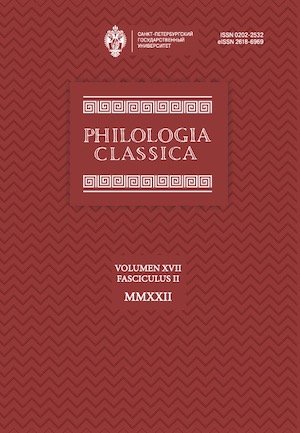A Rudimentary Motif in Greek Epic (Pylos Combat Agate and the Iliad 3. 369–376)
DOI:
https://doi.org/10.21638/spbu20.2022.201Аннотация
В 2015 году Дж. Дэвис и Ш. Стоккер, раскапывая т. н. .могилу воина с грифоном. в Пилосе, обнаружили агатовую печать с изумительным по тщательности изображением батальной сцены. Изображен герой, вооруженный одним только мечом, который перегибается через щит и хватает противника за навершие шлема, чтобы, пользуясь им как рычагом, сделать соперника совершенно беспомощным. В статье рассматривается данное изображение как отражение эпизода из раннего героического эпического повествования. Делается попытка показать, что описание боя Менелая и Париса в Il. 3. 369–376 представляет собой авторское изменение традиционного повествования, сохранившегося в тексте Илиады только как рудиментарный мотив в соответствии с определением Ф. Ф. Зелинского. Предлагается по-новому комментировать сам эпизод Iliad 3. 369–376, в котором описание включает шлем необычной конструкции, модный в 16–15 вв. Именно такой шлем позволял воину при сопутствующей удаче повернуть голову противника так, как это изображено на Пилосском боевом агате. Характерно, что гомеровское описание результата битвы вводится с помощью .Если бы не., отрицающего то, что в предшествующей традиции должно было составлять основу повествования. В качестве результата предлагается реконструкция нескольких фрагментов героического эпоса раннего микенского времени с привязкой, как это уже предполагал Ройх, к Пелопоннесу 17–15 вв.
Ключевые слова:
Греческая эпическая традиция, Hom. Il. 3.369–376, рудиментарный мотив, Пилосский боевой агат
Скачивания
Библиографические ссылки
Fenik B. Typical Battle Scenes in the Iliad. Studies in the Narrative Techniques of Homeric Battle Description. Wiesbaden, Steiner, 1968.
Ruiperez M. S., Vara J. Le mycénien et les traces d’occlusives finales dans le texte homérique. Minos 1972, 13 (2), 192–196.
Загрузки
Опубликован
Как цитировать
Выпуск
Раздел
Лицензия
Статьи журнала «Philologia Classica» находятся в открытом доступе и распространяются в соответствии с условиями Лицензионного Договора с Санкт-Петербургским государственным университетом, который бесплатно предоставляет авторам неограниченное распространение и самостоятельное архивирование.






